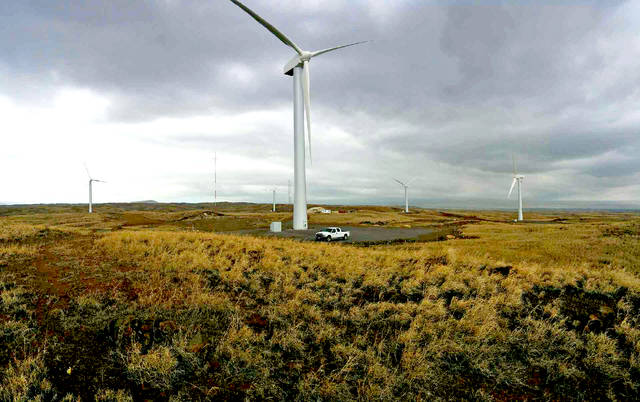KAILUA-KONA — A decision by the Hawaii County Water Board at its monthly meeting Tuesday may signal the end of an award-winning renewable energy project and prove the impetus for a legal battle with implications amounting to tens of millions of dollars.
The board found the Hawaii County Department of Water Supply (DWS) has complied with a power purchase agreement it entered into with the Lalamilo Wind Company (LWC) in 2013. That year, LWC won a bid to exclusively supply eight deep wells at the DWS Lalamilo-Parker Well Sites in South Kohala with clean, renewable wind energy.
Richard Hardin, member/manager at LWC, called Tuesday’s unanimous decision “very disappointing.” And he didn’t stop there.
“They think they’re prevailing in the short run, but in the long run they’re destroying the project,” he said of DWS, his company’s opponent in the matter the board decided on Tuesday. “Pitiful.”
Hardin added the board’s move is likely to spur a lawsuit on the part of his company.
“From this point on, we’re either going to negotiate something promptly, or we’re going to have to file litigation,” he said.
The dispute centers on contract stipulations in the power purchase agreement, which LWC contends require DWS to purchase at least 8,000 megawatt hours (Mwh) of renewable electricity annually to keep the wind farm financially viable.
Will Rolston, former Hawaii County energy coordinator who worked on the power purchase agreement and was part of the three-person committee that oversaw the request for proposal (RFP), has supported LWC’s position from the onset of the dispute. He said no company would have submitted a bid without such a guarantee, as DWS was to be the winner’s only viable client.
Julie Myhre, a former DWS employee and the second member of the three-person RFP committee, submitted a letter to the Water Board on the issue. Like Rolston, she also voiced support for the position of LWC.
The Water Board, which pushed its decision multiple months so as to hear both sides of the argument and consult with Hawaii County Corporate Counsel, ultimately disagreed.
“Basically, their statement was that we’re following the terms of the contract,” Keith Okamoto, DWS manager-chief engineer, said following the meeting.
Craig Takamine, Water Board chair, said the board’s decision essentially amounted to a contractual interpretation that DWS has an obligation to buy only as much energy as it can, when it can — even if that doesn’t add up to 8,000 Mwh.
Part of the problem with DWS’s ability to accept LWC wind energy has been malfunctioning wells at the site in question. Of the eight wells, only four were operational before July.
A fifth was brought back online last month, and department officials said Tuesday that a sixth well is now operational. It had been deemed in need of repair but further assessment proved that was unnecessary, officials said.
DWS had been purchasing only about half of the energy LWC produced, but in recent months that number has kicked up to about two-thirds. Still, Hardin said that’s not enough to sustain the wind farm financially in the long run.
“What’s going on is they’ve been sitting trying to figure out how they’re going to beat us out of what’s due on these months of operation, and what may be due, until they can come into compliance,” Hardin contended. “And the net result of that is to simply destroy a very good project.”
Hardin added he met with then-mayor Billy Kenoi, saying Kenoi referred to the project as part of “his legacy.”
Rolston said Tuesday when he reflects on his near-decade tenure in county government, he considers the project the best thing he accomplished. The reason for that is the impact it can have on renewable energy prevalence in Hawaii County.
Despite roughly 70 water sources across the island, the eight deep wells at Lalamilo-Parker Well Sites account for roughly 25 percent of DWS energy consumption, and the department is the largest consumer of energy in Hawaii County.
Litigation from LWC, if it comes down, would almost certainly name DWS as the primary defendant. However, it may also include Hawaii County as a defendant.
Because DWS is classified as a semi-autonomous county agency and retains the services of the county’s Corporation Counsel, legal liability is murky.
LWC has retained counsel of its own, who Hardin said has been in contact with Joseph Kamelamela, head corporation counsel for Hawaii County. Hardin added he’s hopeful communication can keep the wind farm alive.
“With enough effort, even (DWS) will understand the difference between right and wrong,” Hardin said.
He added, however, LWC is prepared for relatively immediate legal action if an agreement can’t be reached.
“If they don’t recognize their responsibility, then we have to go the next step,” he said.
The next step would include seeking restitution for LWC’s entire investment, which Hardin said now exceeds $15 million. Losses in profit since the wind farm began operations in 2016, as well as other monetary damages, would also likely be sought in any lawsuit.
Craig Masuda, deputy corporation counsel for the county who was in attendance Tuesday, said it’s difficult to say how representation for DWS and other potential defendants would play out until something official is filed. Thus, precise impact to the taxpayer also remains unclear.
“Chances are Corporation Counsel would be involved somehow in any representation,” Masuda said.

